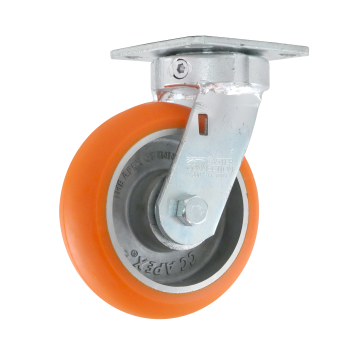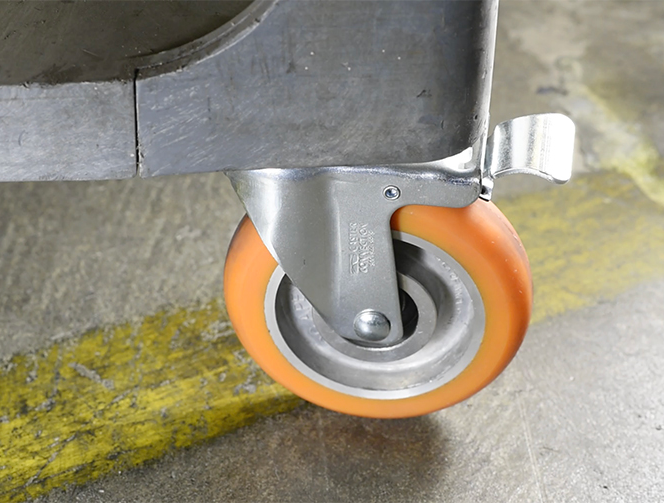Caster Solutions for Glass Manufacturing and Installation

Imagine guiding a tall, pristine sheet of glass across a bustling shop floor. Every step is calculated. Every bump, vibration, or slip of control is a potential disaster—a single fracture could cost thousands.
In glass manufacturing and installation, there’s no margin for error. Products are fragile. Movements must be deliberate. And the difference between flawless delivery and shattered loss often comes down to one overlooked factor: mobility.

Casters may not steal the spotlight, but in this high-stakes environment, they are critical. From minimizing micro-fractures to improving ergonomics and controlling every inch of movement, the right caster and braking combination protects your product, your timeline, and your team.
Here’s how.
Why Glass Handling Demands Specialized Mobility Solutions
From the moment a panel is cut to its final installation, glass demands care at every touchpoint. The challenges are unique: it’s heavy but fragile, large but delicate, and unforgiving to even the smallest misstep. Standard mobility solutions simply don’t cut it. To move glass safely and efficiently, you need caster systems engineered to meet the material’s exacting demands—supporting your product, your people, and your workflow.
High Value, High Fragility
Glass is a premium material, both costly to produce and highly noticeable when damaged. Chips, cracks, and edge fractures can turn a flawless pane into expensive waste. In architectural or commercial applications, visual imperfections are simply unacceptable.

Large, Awkward Sizes
Glass panels are often large and thin, making them difficult to grip, balance, or stabilize during movement. Lifting by hand increases the risk of injury and breakage. Safe handling requires mechanical assistance that provides both strength and sensitivity.

Precision Is Everything
Whether staging panels for cutting or positioning them for window frame installs, movements must be precise and stable. Swivel misalignment or a lack of braking control can compromise both accuracy and safety.

High Injury Risk
Workers in glass handling face frequent ergonomic injuries and laceration risk. Without the right tools, tasks that should be smooth and efficient become hazardous.

How Casters Improve Safety, Efficiency, and Product Integrity

Casters play a crucial role in maintaining the safety, speed, and precision required for glass handling, both in production environments and on job sites. By enabling smooth movement, reducing physical strain, and protecting delicate materials from shock and vibration, the right caster setup helps teams work more efficiently while minimizing the risk of damage or injury. Whether transporting panels across the factory floor or positioning them in a finished space, casters enhance every stage of the process.
On the Factory Floor
Caster-equipped carts and staging racks:
• Reduce the need for heavy lifting or glass flipping.
• Allow for smooth, low-impact transport between stations.
• Absorb vibration to protect polished edges and prevent micro-damage during transit.
On the Job Site
Whether you’re fitting glass into curtain walls, retail displays, or custom homes:
• Mobility solutions help navigate narrow access points and tight spaces.
• Workers can fine-tune placement without relying solely on cranes or lifts.
• Ergonomic design reduces fatigue while increasing jobsite safety.
Essential Caster Features for Glass Manufacturing and Installation
Not all casters are created equal—especially when it comes to handling glass. The right features can mean the difference between smooth, damage-free transport and costly setbacks. From protecting fragile panels to improving worker control and comfort, each component of a caster plays a role in overall performance. Here are the key features to prioritize when selecting casters for glass manufacturing and installation.
1. Shock Absorption
Glass is strong, but it’s not forgiving. Shock-absorbing casters protect against:
• Micro-vibrations that can weaken panels.
• Bumps and impacts from rough terrain or thresholds.
• Edge and surface damage during transitions.

2. Non-Marking Wheels
In cleanrooms or finished interior spaces, non-marking wheels are essential. They prevent streaks and scuffs on floors while providing quiet, low-resistance rolling that supports precision and cleanliness in sensitive environments.

3. Low Rolling Resistance and Quiet Operation
Ergonomic casters with low rolling resistance require less effort to move, which reduces strain on workers and supports better ergonomic practices. Quiet operation is equally important, especially in environments where concentration, communication, and precision are critical. Together, these features create a smoother, safer, and more efficient workflow.

4. Precision Steering and Maneuverability
Tight turns and narrow paths are common in glass staging and install.
Swivel casters with stable tracking and responsive control are key to avoiding slips and tip hazards.

The Life-Saving Power of Braking and Stability

A runaway cart loaded with glass is more than just dangerous; it can be deadly. When handling tall, heavy, and sharp-edged material, any loss of control can result in serious consequences.
Casters by themselves are not enough. A reliable braking system is essential to protect both workers and product integrity in real-world conditions.
Braking Features That Prevent Disaster

To address the risks of uncontrolled movement, braking systems must be thoughtfully selected and tailored to the demands of glass handling. Each type of brake plays a specific role in stabilizing equipment and preventing accidents on the floor or in the field. Below are the key braking solutions that help ensure both safety and control.
Deadman Brakes
These brakes engage automatically when the operator releases the cart handle or pedal. As spring-loaded fail-safes, they keep the cart securely locked when unattended, which is especially important on sloped or uneven flooring.
Floor Locks
Designed to press firmly into the floor, these locks stabilize the entire cart. They are ideal during inspections, fine adjustments, or installations where even slight movement could lead to risk.
Total-Lock Brakes
These brakes lock both the wheel and the swivel, preventing any rotation or rolling. This level of control is essential for tasks that require precise glass placement.
Effective braking helps you maintaining control when it matters most. In glass handling, that control can make the difference between a safe operation and a serious incident.
What to Look for in Glass-Handling Casters

Here’s a quick checklist for selecting the right caster solution:
- High shock-absorbing tread (polyurethane or similar)
- Non-marking, smooth-rolling wheels for clean spaces
- Low push resistance for ergonomic movement
- Excellent maneuverability in tight areas
- Reliable braking systems: deadman, floor lock, total-lock
- Load capacity tailored to rack or panel type
- Moisture- and corrosion-resistance for outdoor jobs
Shop Casters Solutions for Glass Manufacturing and Installation
6" CC Apex set - 2 swivel/2 rigid
SKU: CC-10/1210-600200-40-T1-SET4
ALT-SKU: CCAPEX-6S/R-set-2s/2r
-
- Overall Height
- 7-1/2"
- Wt. Capacity
- 1,000 lbs.
- Wheel Width
- 2"
- Wheel Diameter
- 6"
SKU: CC-1210-800200-40-T1
ALT-SKU: CCAPEX-8S
-
- Overall Height
- 9-1/2"
- Wt. Capacity
- 1,200 lbs.
- Wheel Width
- 2"
- Wheel Diameter
- 8"
SKU: CC-1010-600200-40-T1
ALT-SKU: CCAPEX-6R
-
- Overall Height
- 7-1/2"
- Wt. Capacity
- 1,000 lbs.
- Wheel Width
- 2"
- Wheel Diameter
- 6"
SKU: CC-1210-600200-40-T1
ALT-SKU: CCAPEX-6S
-
- Overall Height
- 7-1/2"
- Wt. Capacity
- 1,000 lbs.
- Wheel Width
- 2"
- Wheel Diameter
- 6"
SKU: CC-1010-800200-40-T1
ALT-SKU: CCAPEX-8R
-
- Overall Height
- 9-1/2"
- Wt. Capacity
- 1,200 lbs.
- Wheel Width
- 2"
- Wheel Diameter
- 8"
8" CC Apex Kingpinless Swivel Caster w/ Built in Brake
SKU: CC-2110-800200-40-T1-BIB
ALT-SKU: CCAPEX-8S-KP-BIB
-
- Overall Height
- 9-1/2"
- Wt. Capacity
- 1,200 lbs.
- Wheel Width
- 2"
- Wheel Diameter
- 8"
5" CC Apex Threaded-Stem Swivel Caster
SKU: DC-2110-500125-40-SX
ALT-SKU: CCAPEX-525-S-THREADED-STEM-1/2
-
- Overall Height
- 6"
- Wt. Capacity
- 450 lbs.
- Wheel Width
- 1-1/4"
- Wheel Diameter
- 5"
SKU: 3-30-312-2
-
- Overall Height
- 4-1/8"
- Wt. Capacity
- 260 lbs.
- Wheel Width
- 1-1/4"
- Wheel Diameter
- 3"
SKU: 3-31-312-2
-
- Overall Height
- 4-1/8"
- Wt. Capacity
- 260 lbs.
- Wheel Width
- 1-1/4"
- Wheel Diameter
- 3"
Real-World Example: A Smarter Approach to Efficiency and Safety
A glass fabrication company specializing in custom storefronts was facing repeat product loss during handling and transport. After switching to shock-absorbing casters with integrated deadman brakes, they saw immediate benefits:
• 60% reduction in breakage during staging and inspection
• Improved crew confidence and fewer ergonomic injury reports
• Faster turnaround between production and packaging phases
Their team now moves with confidence and their clients receive flawless panels, every time.

Mobility That Protects What Matters Most
Glass is an unforgiving material. A single misstep can lead to costly damage or serious injury. With the right caster and braking system, however, every movement becomes safer, more controlled, and more efficient.
In glass manufacturing and installation, casters are not just components. They are essential tools that support safety, preserve product quality, and enhance overall performance.
Need casters that can handle your heaviest, most fragile loads? Start Your Caster Needs Evaluation today.
